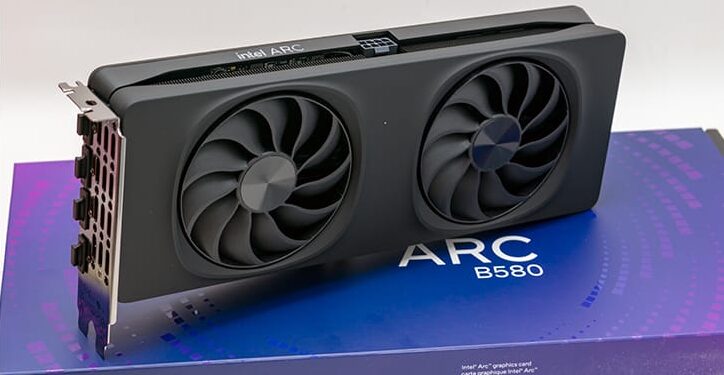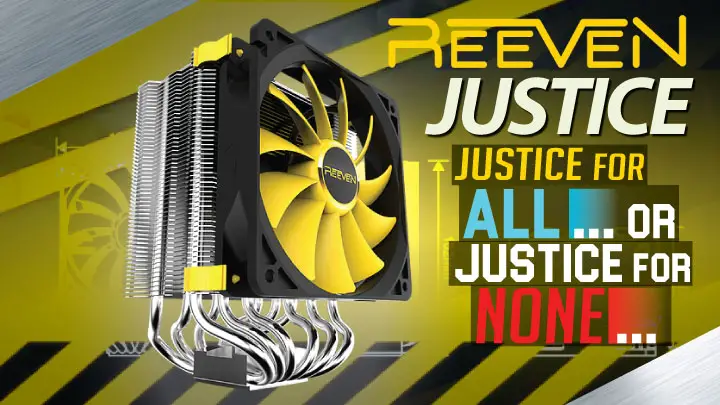
It is funny but if one has never purchased anything other than a CPU from Intel the shipping container may come as a bit of surprise. A pleasant surprise, but a surprise never the less as this box is not boring. It is not plain. It is not even clad in “Intel Blue” like their CPUs (tiny) box use. Put bluntly, where their CPU division is all about ultra-conservativism and come across as a bit on the ‘cold’ side their dGPU “ARC” division is all about being approachable by the average jane or joe.
Make no mistake, Intel ARC shipping containers are still on the conservative end of the spectrum compared to say a Gigabyte VIPERIA. To us the fact you will not find epileptic seizure inducing color schemes, over the top ‘I AM A GAMER’ graphics, nor even the typical dross that has infected the video card industry is not a good thing. It is a great thing. Thanks to its quiet, understated, elegance this is a shipping container that instills confidence in potential buyers thinking about expanding their horizon past Team Green or Team Red options.

With all that said, it may be a bit too boring for some. It really is a shame that you will not typically be able to see inside the box until you purchase it as this charmingly minimalistic exterior does not extend to the internals. Instead of seeing a stripped down internal protection scheme Intel has gone all out. Multiple layers of colorful, and graphic laden, internal cardboard covering a high density foam ‘cutout’ that lets the ARC B580 stay safe and sound. Be it from blunt force, an iterant box cutter, or darn near anything else this bomb proof box is so far above average it breaks the bell curve.

With that said… we could do without some of the accessories. Does anyone really need a carboard ‘do it yourself’ ARC toy? Hopefully that is just a reviewer’s “Limited Edition” inclusion as ooof. Give me a couple bucks off the MSRP instead of it. After all, if I want to play with any video card its not going to involve children’s toys. It is going to involve Hell Diver… err… Battlefiel… err The Final… err… okay. Maybe we can see Intel’s point of view on toys. All jokes aside, this cardboard toy accessory (with stickers!) did increase the build cost and considering this is a 250 and not $180 like the A580 was… maybe Intel needs to think a bit more inside the box?

Moving on. Thankfully, this… whimsical touch does not translate into a glowy, showy, LED lightshow clad card. Instead when you look at the B580 for the first time you are strongly reminded of some of the best Founders Editions and other premium looking dGPUs we have reviewed over the years. Put blunt, the softly sloping sides, the graceful curves and even a freakin backplate (on a $250 card we may add!) is phenomenal.

Sure, the backplate is polymer and not metal. Few will care as it is a backplate clad model in a sea of nekkid options. Yes, this is a video card that does not look like an inexpensive card. Instead it could easily be part of a uber high end custom build, a more industrial looking build, or even a corpo-build. It is just that elegant and that flexible in its aesthetics. AMD (and to lesser extend NVIDIA) could learn a thin or two about how to do video card aesthetics right from Intel.

With that said, and much like the shipping container, certain demographics will find it a bit too conservative. As such, if you are 1337 gamer reliving your youth, a TickTok’er with TickTok brain, or even just a YouTube “influencer” you probably will be very bored with the B580. Maybe that is a good thing as “influencers” have ruined multiple industries just for “clout” already. So maybe flying under their radar for a couple more generations is a good thing. Put another way Intel is serious about their ARC division and are trying to take AMD’s place as the plucky underdog who under promises and over delivers. Which would be a refreshing change of pace compared to modern Team Red and Team Green marketing shenanigans – with over the top claims that they may try (kinda-sorta) at some point in the future to actual deliver on. Either way, AMD should be concerned as this is a card that looks like it deserves to be in a mainstream build.

Make no mistake. The new ARC 2.0 / BattleMage B580 is not just a pretty face. This is a well designed card. One that Team Green and Team Red’s entry mainstream design teams could learn a thing or two from on more than just aesthetics. For example, this is not a card rocking a ‘blower’ style cooling solution. Over the years too many companies have cut corners by using blowers instead of ‘down draft’ solutions as they are cheaper to implement, and with under 200watt TDPs are generally considered ‘good enough’. They however are loud. In testing this card is not silent but its dual custom ~89mm fans rarely get loud enough to be overly noticeable and for the most part will be lower than ambient noise created by the typical inexpensive case’s 120/140mm fans.

Furthermore, the cooling design of this downright inexpensive (by 2024 standards) dGPU is excellent. You have the frontmost fan in a passthrough design reminiscent of a CPU cooling solution (or… Founders Edition) that will actually provide most of the core’s cooling while the rearmost fan acts a more standard downdraft fan that provides much needed air movement not only over the cooling array’s aluminum fins but also the GDDR6 RAM ICs… and the rest of the components on the rather small PCB.

To dig down and be a bit more precise Intel has opted for a single slot height full length fin array that is cooling 5 heatpipes.

Considering this card is 27.5CM long, the card is ~99.5mm “wide” (or about 4.2mm over PCIe SIG’ zheight standard) and the array is 20mm “tall”… there is a lot of surface area (~270 square cm) for this 190TDP video card. All without ballooning the dimension up to 3 slots form-factor.

Before we move on. We do need to make one thing clear. We are in no shape nor form slamming the fact that the overall length of the PCB makes up only about half of the overall length of the B580. The opposite is in fact true. A small PCB has proven to be better than overly long ones – as it does allow for better cooling and lower noise. It also allows, if a company decides to make one, for smaller ‘full coverage’ water blocks. All of which are good things. Sadly, going hand in glove with all those benefits to short boards is the fact that the power connector is in a bad location.

Yes, modern GPUs typically stick them half way down the board but this modern trend is trash. It makes final tidying up way, way harder than the ‘old school’ method of sticking the 8-pin(s) on the end of the card. On the positive side… it is a single 8-pin PCIe connector so there are little worries over an incorrectly inserted cable “melting”… and burning your frickin house down. So while not perfect, we will take even a four 8-pin model over a trash-in-the-bag single 12V-2×6 connector option. The old way is safer, easier to work with, easier to find aftermarket (color matching) cables, and generally speaking just plumb better.

Counteracting some of that positivity is the fact that a single 8pin is rated for 150 watts of power. Considering this is a card that A) has a TDP of 190 watts and B) allows for easy overlocking via its software… we are not precisely overjoyed with seeing a single connector being used. It should have been one 8 + one 6 pin. That way no power would ever be pulled via the PCIe slot, no gremlin limitations on overclocking (as while the PCIe spec is for 75 watts… not every board can supply clean, stable power at that level). Hopefully, third party / board partners will release a more… overclocking friendly version that is rocking dual connectors (like say a three fan ASRock Steel Legend model).

Circling around the rearIO ports we can see that Intel has opted for a very decent 3xDP 2.1 + 1xHDMI 2.1a port configuration. While we would have liked to have seen a USB port (for VR) having them all stacked on a single slot layer and the second for helping exhausting hot air… we can not complain to much.








